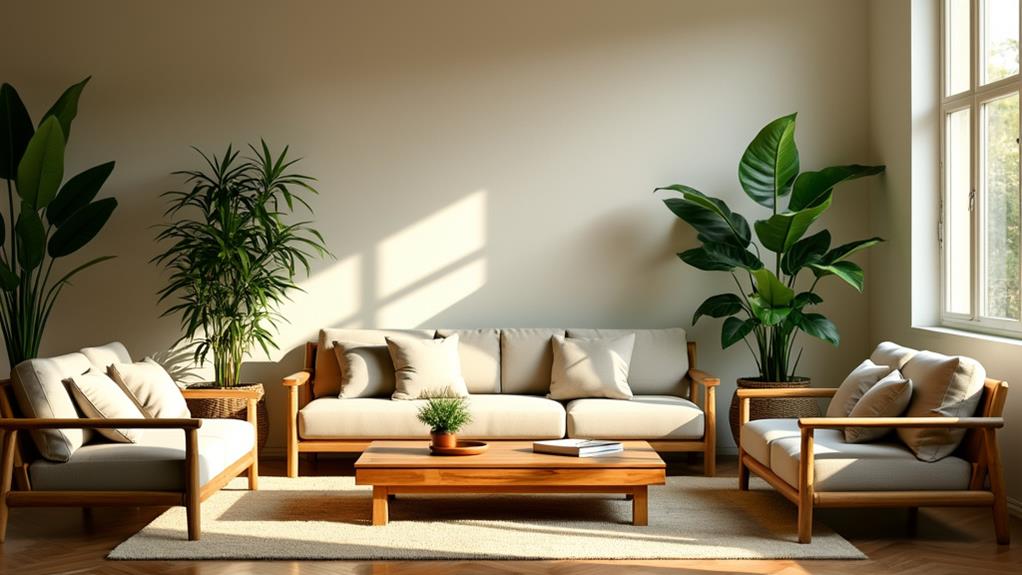Transform your home with eco-friendly furniture by incorporating products made from sustainable materials, like bamboo and reclaimed wood, which support environmental conservation. Eco-friendly furniture often features non-toxic finishes and low VOC paints, improving indoor air quality and ensuring your family's safety. Organic fabrics, free from harmful pesticides, offer both comfort and protection. Choosing pieces with recycled materials reduces landfill waste, promoting a more sustainable lifestyle. Beyond sustainability, eco-friendly furniture adds aesthetic value, with unique textures and designs that enhance your living space. Consider these factors as you explore how eco-friendly furniture can transform both your home and lifestyle.
Table of Contents
ToggleUnderstanding Eco-Friendly Furniture
When you opt for eco-friendly furniture, you're choosing sustainability and minimizing your environmental impact. This type of furniture is crafted with care, using materials from managed forests, which promotes conservation and replanting efforts.
You'll find that organic fabrics, free from harmful pesticides, are used in sofas, ensuring safety and comfort. Additionally, eco-friendly furniture often features non-toxic finishes, preventing volatile organic compounds (VOCs) from affecting indoor air quality.
Consideration of the product's lifecycle is essential, with an emphasis on using recycled materials and reclaimed wood, substantially reducing landfill waste. Sustainable furniture is made from renewable or recycled materials, focusing on minimizing waste and energy consumption.
These choices contribute to a healthier indoor environment, aligning with eco-conscious living.
Benefits of Sustainable Materials
Choosing eco-friendly furniture is more than just an aesthetic decision; it directly impacts the environment by utilizing sustainable materials.
Sustainable wood furniture supports responsible forest management, reducing environmental damage. Through selective harvesting, higher quality wood is achieved, enhancing durability.
Reclaimed wood, often sourced from old structures, reduces demand for new timber, offering unique characteristics and a story.
Bamboo is a standout choice due to its rapid growth and sustainability, providing strength and long-term usability.
Recycled material seating repurposes waste into functional furniture, addressing landfill overflow and supporting green business practices.
Health and Safety Considerations
Addressing health and safety considerations is essential when selecting eco-friendly furniture. Ensuring that your home environment is safe and healthy means choosing pieces designed to minimize chemical exposure and improve indoor air quality.
Non-toxic finishes on dressers and tables prevent volatile organic compounds (VOCs) from entering your space. Opt for low-VOC paints to further enhance air quality, especially beneficial for those with allergies or sensitivities.
Additionally, plant-based mattresses made from organic cotton and latex contribute to a healthier sleep environment.
- Non-toxic finishes: Reduce harmful chemical exposure.
- Low-VOC paints: Improve air quality, ideal for sensitive individuals.
- Plant-based mattresses: Promote a healthier sleep environment.
Aesthetic Appeal of Eco-Friendly Furniture
Eco-friendly furniture doesn't just benefit the planet; it also brings unique aesthetic appeal to your home.
With a focus on style and safety, these pieces support sustainable manufacturing practices. Sustainable wood tables, for instance, display distinct grains and textures, offering a story with each piece.
Organic fabric sofas come in various textures and colors, allowing you to express personal style while ensuring comfort.
Non-toxic finish dressers merge aesthetics with responsibility, providing a wide range of styles that suit any decor.
Solar-powered lamps add versatility, enhancing your home's aesthetic with their diverse designs while being eco-friendly.
Impact on Sustainability
While the aesthetic appeal of eco-friendly furniture enhances your home, its impact on sustainability extends well beyond mere appearance. By choosing eco-friendly pieces, you actively support a healthier planet and contribute to a sustainable future.
Here's how:
- Resource Conservation: Eco-friendly furniture often uses materials from sustainable sources, like managed forests or recycled goods, reducing strain on natural resources.
- Waste Reduction: By incorporating recycled or reclaimed materials, this furniture minimizes landfill waste, promoting a more circular economy.
- Energy Efficiency: Many pieces are crafted with reduced energy consumption in mind, lessening the carbon footprint associated with production.
Choosing the Right Eco-Friendly Pieces
When you're selecting eco-friendly furniture, it's essential to take into account both environmental impact and functionality.
Start by evaluating materials. Opt for pieces made from sustainable resources like bamboo or reclaimed wood, which minimize environmental harm. Look for certifications such as FSC (Forest Stewardship Council) to guarantee responsible sourcing.
Consider the durability of the furniture, as longer-lasting items reduce the need for frequent replacements, thereby lowering waste. Check for non-toxic finishes and adhesives, which promote healthier indoor air quality.
Functionality is equally important; make sure the furniture meets your practical needs. Whether it's a multi-purpose table or a comfortable organic fabric sofa, balance between environmental responsibility and usability.
This approach guarantees your choices are both sustainable and practical.
Incorporating Eco-Friendly Furniture Styles
Incorporating eco-friendly furniture styles into your home can greatly enhance both your living space and environmental footprint. By choosing sustainable options, you align aesthetics with responsibility.
Consider the following strategies to seamlessly integrate these pieces:
- Mix Materials: Combine reclaimed wood and recycled metals for a unique, balanced look.
- Focus on Functionality: Opt for multipurpose furniture that minimizes waste and maximizes space.
- Embrace Natural Textures: Select organic fabrics and non-toxic finishes to enhance both comfort and safety.
These choices don't just elevate your interior design; they also contribute to a healthier planet.
Eco-friendly furniture supports sustainable practices, reduces carbon footprints, and minimizes waste. By integrating these styles, you promote a conscious lifestyle, proving that elegance and environmental care can coexist harmoniously in your home.


